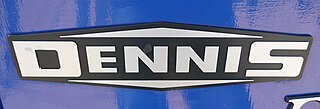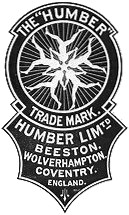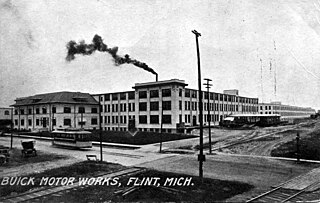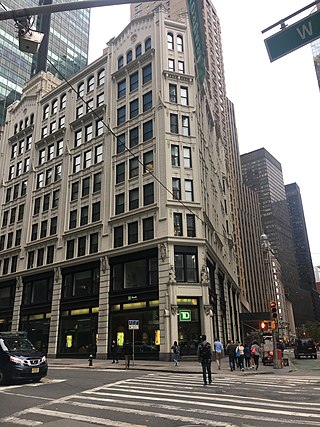
Guildford is a town in west Surrey, England, around 27 mi (43 km) south-west of central London. As of the 2011 census, the town has a population of about 77,000 and is the seat of the wider Borough of Guildford, which had around 145,673 inhabitants in 2022. The name "Guildford" is thought to derive from a crossing of the River Wey, a tributary of the River Thames that flows through the town centre.

Dennis Specialist Vehicles was an English manufacturer of commercial vehicles based in Guildford, building buses, fire engines, lorries (trucks) and municipal vehicles such as dustcarts. All vehicles were made to order to the customer's requirements and more strongly built than mass production equivalents. For most of the 20th century the Dennis company was Guildford's main employer.

Humber Limited was a British manufacturer of bicycles, motorcycles, and cars, incorporated and listed on the stock exchange in 1887. It took the name "Humber & Co Limited" because of the high reputation of the products of one of the constituent businesses that had belonged to Thomas Humber. A financial reconstruction in 1899 transferred its business to Humber Limited.

The Autostadt is a visitor attraction adjacent to the Volkswagen factory in Wolfsburg, Germany, with a prime focus on automobiles. The complex was designed by Henn GmbH.

Buick City was a massive, vertically-integrated automobile manufacturing complex in northeast Flint, Michigan, which served the Buick home plant between 1904 and 1999. In the early 1980s, after major renovations were completed to better compete with Japanese producers, the plant was renamed to "Buick City".

White and Poppe Limited was a proprietary engine building and gearbox manufacturing business established in Coventry in 1899 by Alfred James White (1870-) and Norwegian Peter August Poppe (1870-1933). Many early motor vehicle manufacturers bought in their major components so the company supplied up to 15 customers and employed around 350 people by 1914. Market changes reduced the customer-base but Dennis Brothers, always an important customer, took much of their output and purchased the company in 1919.
The Studebaker Building is a former structure at 1600 Broadway on the northeast corner at 48th Street in Manhattan, New York City. It was erected by the Juilliard Estate, in 1902, between Broadway and 7th Avenue, in the area north of Times Square. It was demolished in 2004 to make room for an apartment tower, a twenty- five story, 136 unit, luxury condominium designed by architect Einhorn Yaffee Prescott.

The Adams Building, formerly the Adams and Page warehouse on Stoney Street, is the largest building in the Lace Market district of the city of Nottingham in England.

Asia House at No. 82 Princess Street, Manchester, England, is an early 20th century packing and shipping warehouse built between 1906 and 1909 in an Edwardian Baroque style. It is a Grade II* listed building as at 3 October 1974. Nikolaus Pevsner's The Buildings of England describes the warehouse, and its companion, No. 86, Manchester House, as "quite splendid ... good examples of the warehouse type designed for multiple occupation by shipping merchants". It attributes its design to I.R.E. Birkett, architect of the Grade II listed companion building, Manchester House, which is similar in design. English Heritage attributes it to Harry S. Fairhurst. Asia House has an "exceptionally rich" entrance hall and stairwell, "lined with veined marble and green and cream faience, with designs of trees and Art Nouveau stained glass".

The J.S. O'Connor American Rich Cut Glassware Factory, also known as the Maple City Glass Company, H.W. Kimble Silk Company, and Arrow Throwing Company, is an historic glassware factory and silk mill located in Hawley, Wayne County, Pennsylvania.

Thomas Dixon Centre is a heritage-listed former factory and now a venue for the performing arts at 406 Montague Road, West End, Queensland, Australia. It was built in 1908. It is also known as Dixon's Shoe Centre and T C Dixon & Sons. It was added to the Queensland Heritage Register on 5 October 1998.

Walter Reid Community Arts Centre is a heritage-listed former warehouse and now community arts centre at 203 East Street, Rockhampton, Rockhampton Region, Queensland, Australia. It was designed by Hutton & Hockings and built from 1900 to 1902 by Dennis Kelleher. It is also known as Walter Reid & Co. It was added to the Queensland Heritage Register on 21 October 1992.

The Barnes Building, originally known as the Odd Fellows' Block, the Masonic Temple from 1909 to 1915, and later Ingram Hall, is a historic fraternal and office building located at 2320-2322 1st Avenue in the Belltown neighborhood of Seattle, Washington. Designed in early 1889 and constructed in late 1890 by Seattle Lodge No. 7 of the International Order of Odd Fellows and designed for use by all of the city's Odd Fellow lodges, it is the earliest known surviving work of Seattle architect William E. Boone and George Meeker and remains in an almost perfect state of preservation. The Barnes building has played an important role in the Belltown Community and Seattle's dance community. It was used by the Odd Fellows for 17 years before their departure to a newer, bigger hall in 1909 and was home to a variety of fraternal & secret societies throughout the early 20th century, with the Free and Accepted Masons being the primary tenant until their own Hall was built in 1915. The ground floor has been a host to a variety of tenants since 1890 ranging from furniture sales to dry goods to farm implement sales and sleeping bag manufacturing, most recently being home to several bars. It was added to the National Register of Historic Places as The Barnes Building on February 24, 1975.

The Willard Manufacturing Company Building is a historic factory building at 25 Stowell Street in the city of St. Albans, Vermont. Built in 1896, the building saw industrial uses continuously until 2006, retaining many original early period features. It was listed on the National Register of Historic Places in 2006.

The Mansuy and Smith Automobile Showroom Building is a historic commercial building at 38-42 Elm Street in Hartford, Connecticut. Built about 1900, it is an early example of an automobile showroom, used by a local carriage manufacturer seeking to transition to the new technology. It was listed on the National Register of Historic Places in 2016.

Dennis Brothers Limited was an English manufacturer of commercial vehicles based in Guildford. It is best remembered as a manufacturer of buses, fire engines and lorries (trucks) and municipal vehicles such as dustcarts. All vehicles were made to order to the customer's requirements and more strongly built than mass production equivalents. Dennis Brothers was Guildford's main employer.

The Commercial Exchange Building, also known as the Collins Manufacturing – Jackson Automobile Company complex, is an industrial building complex located at 2301 E. Michigan Ave. in Jackson, Michigan. The building was built partly in 1895, and was listed on the National Register of Historic Places in 1993. The listing included four contributing buildings.

The Old Bushells Factory is a heritage-listed former Bushells Tea factory and warehouse, now used as shops, offices and an art gallery, located at 86–88 George Street in the inner city Sydney suburb of The Rocks in the City of Sydney local government area of New South Wales, Australia. No. 86 was designed by Walter Liberty Vernon; and both buildings were built from 1886 to 1912. It is also known as the Old Bushells Factory and Warehouse; Bushells Place; Bushells Warehouse and Bushells Offices; and Health Commission Building (Bushell's). The property is owned by Property NSW, an agency of the Government of New South Wales. It was added to the New South Wales State Heritage Register on 10 May 2002.

The Warren Motor Car Company Building, also known as Lincoln Motor Car Company Building, is a factory located at 1331 Holden Street in Detroit, Michigan, now part of the Lincoln Street Art Park. It was listed on the National Register of Historic Places in 2020.

224 West 57th Street, also known as the Argonaut Building and formerly as the Demarest and Peerless Company Building, is a commercial building on the southeast corner of Broadway and 57th Street in Midtown Manhattan, New York City, just south of Columbus Circle. The building consists of two formerly separate structures, the A. T. Demarest & Company Building and the Peerless Motor Car Company Building, both used by automobile companies. Both structures were designed by Francis H. Kimball and erected by the George A. Fuller Company with similar Gothic Revival and Romanesque Revival architectural details.























